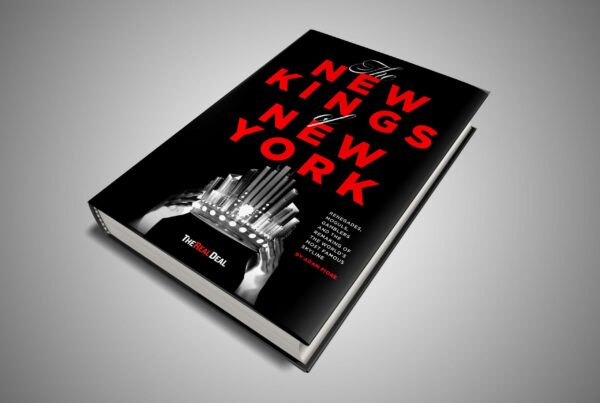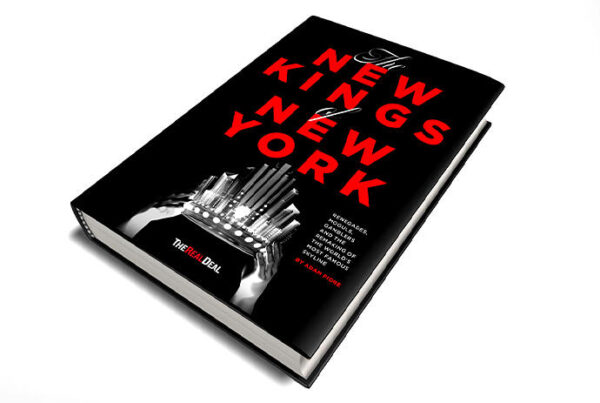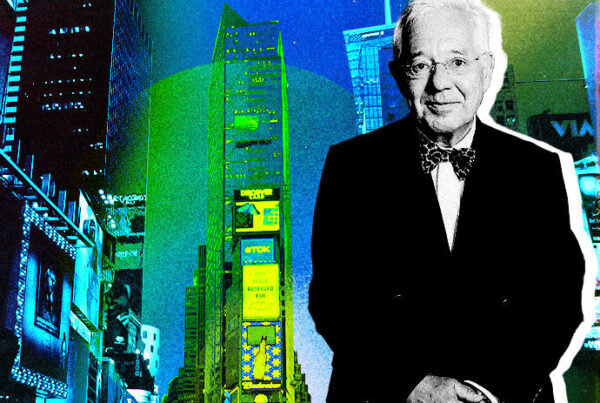 Manhattan’s Paramount Group received an unsolicited takeover bid early last month for about two-thirds of what the company was worth prior to Covid.
Manhattan’s Paramount Group received an unsolicited takeover bid early last month for about two-thirds of what the company was worth prior to Covid.
Just a few weeks later, the real estate investment trust’s board unanimously rejected the offer from activist investor Bow Street, noting that its offer was “inadequate and significantly undervalues” the office landlord run by Albert Behler.
The hedge fund’s bid, however, was in line with Paramount’s stock price, which plunged at the onset of the pandemic and has hovered at just under $10 a share since. And the REIT, which has a market cap of about $2 billion, may still be on the table for a higher offer.
“Our board and management team remain open-minded,” Behler wrote in a letter to Bow Street’s managing partners.
It’s a tense reality for the pandemic-battered landlord whose trophy office buildings in Manhattan and San Francisco remain mostly empty as the vast majority of employees continue to work remotely.
Meanwhile, Paramount isn’t the only office landlord in hot water.
Vornado Realty Trust recently unveiled plans to reduce compensation and shed 70 jobs to lower its annual overhead costs by more than $35 million. Empire State Realty Trust, likewise, announced plans to lay off six employees and furlough another 156 as part of the firm’s cost-cutting measures, after reporting a net loss for the second consecutive quarter.
“We need to get through a very difficult point now,” Anthony Malkin, Empire State Realty’s chairman and CEO, said in an interview. “I’m highly confident. I’m also a realist. … We probably won’t see the bottom until the first quarter of 2022.”
Paramount declined to comment for this story. Vornado did not respond to requests for comment.
The availability of office space in the biggest markets around the country hit new highs in recent months, as a growing number of tenants look to weather the pandemic and economic fallout by subleasing space. At the same time, struggling hotels and retail assets are being converted into new offices, adding to a potential oversupply in major cities like New York, Chicago, Los Angeles and San Francisco.
Manhattan’s office availability rate was at more than 13 percent last month, the highest level since 2003, with Midtown and Midtown South setting historic records of 14.4 percent and 12.8 percent respectively, according to Colliers International.
“It is significant to acknowledge it,” said Franklin Wallach, Colliers’ senior managing director of New York research. “But of course, we are in very unique times right now with Covid-19.”
The availability of office space in Chicago’s central business district, meanwhile, rose to a rate of more than 22 percent at the end of the third quarter, according to CBRE. In Los Angeles County, the availability rate was at roughly 21 percent as of early December, a recent report from Avison Young found.
And market conditions could get worse before they improve.
 Many workers who finally returned to their offices this fall have retreated again, facing a resurgence of Covid infection rates. Industry experts say the latest vaccine news offers a dim light at the end of the tunnel, but a long road to recovery is still ahead.
Many workers who finally returned to their offices this fall have retreated again, facing a resurgence of Covid infection rates. Industry experts say the latest vaccine news offers a dim light at the end of the tunnel, but a long road to recovery is still ahead.
The WFH reckoning
In an effort to lead by example, SL Green Realty CEO Marc Holliday, who lives in Scarsdale, has been commuting by train since March.
During SL Green’s third quarter earnings call, Holliday lamented the low physical occupancy rate of his firm’s office portfolio.
“We’re still … right around the city average of probably 15 percent to 20 percent back to office work,” he said. “That means 80 percent, 85 percent of the people that work in office buildings are still home, and that’s frustrating.”
SL Green declined to comment.
During recent earnings calls, executives of other office landlords acknowledged that while most tenants have been keeping up with rent payments, the majority have also kept their workers remote. Building owners maintain that they’re creating safe office environments, in an effort to lure back workers, but the recent surge of Covid cases is once again sending people home.
And one contender in New York City’s 2021 mayoral race has added to the list of grievances. “We owe it to our kids to do everything we can to keep schools safe and open,” the city’s comptroller, Scott Stringer, tweeted in mid-November. “Shut down office buildings.”
Nearly nine months into the pandemic, the physical occupancy rate of offices in the country’s top 10 metro markets remains at an average of about 25 percent, according to Kastle Systems, which aggregates data from its swipe card door access system.
Countless office buildings around the U.S. have remained almost completely deserted since the beginning of the pandemic, and the return rates among office workers in San Francisco, New York and Chicago, were among the lowest as of Dec. 2, at 12.8 percent, 14.3 percent and 16.6 percent, respectively. Los Angeles fared better than average at 31.7 percent.
For landlords, physical occupancy matters, said Alex Goldfarb, a senior REIT analyst at Piper Sandler. Similar to Malkin, he predicted that office leasing in major markets like New York will begin to normalize in 2022.
“You really need all the employees to come back to work,” Goldfarb said. “Then employers feel better about how they’re going to handle things and they’ll be able to make growth decisions on leasing.”
Peter Brindley, Paramount’s executive vice president of leasing, has argued the same point.
“One of the things that we subscribe to entirely is that physical occupancy will generate new leasing activity,” he said during the REIT’s third quarter earnings call in late October.
 Pandemic pressures
Pandemic pressures
Compared to hospitality and retail, the office sector has appeared more insulated from the pandemic.
But when dealing with office tenants that are nearing the end of their leases, landlords have had to maneuver carefully. The number of short-term lease extensions has rapidly increased during the pandemic as both property owners and tenants avoid making decisions that could prove to be too concrete in the year ahead, according to industry sources.
At the same time, space available for sublease continues to flood major cities around the country.
As of Nov. 30, Manhattan’s available sublease space was more than 24 percent of the market’s total availability, at about 17.3 million square feet, signaling a “glut” of inventory on the near horizon, Colliers’ Wallach noted.
In Chicago’s central business district, the amount of sublease space on the market has surpassed 5.3 million square feet, the highest on record and about 15 percent of total availability, according to Cushman & Wakefield. And the amount of available sublease space in Los Angeles County in early December was 7.6 million square feet, about 17 percent of total availability, according to Avison Young. That’s also the highest on record, exceeding the 6.5 million square feet in sublease inventory in 2009.
Office landlords have faced a “lot of downward pressure” on pricing as they contend with the “enormous amount of subtlet office available,” said Manus Clancy, senior managing director of the financial data firm Trepp.
In turn, the amount of free months of rent — typically offered by landlords at the beginning of a new lease — has spiked by 30 percent nationwide since the pandemic hit, according to a recent report co-authored by Trepp and CompStak.
Some building owners have also boosted their tenant improvement allowances, said Jonathan Larsen, a commercial broker with Avison Young based in Los Angeles.
Office landlords would prefer to give out more concessions as long as they can maintain their asking face rent because “they are focused on preserving the value of their property,” said Artree Maharajh, Avison Young’s research manager for Los Angeles County.
Local landlords are holding out hope that the market will begin to recover once enough people get vaccinated, Maharajh said. “They’re not trying to do the deals any lower than they need to because, at some point, they’re going to need to sell the building,” he said.
But the far-reaching impacts of Covid could make a full recovery tricky, as tech firms continue to lead the charge on remote working as a way to cut costs and give workers a greater sense of flexibility. Software giant Salesforce, for example, recently told analysts that it plans to consolidate and sublease some of its office space as more people work from home.
On top of that, some owners of struggling hospitality and retail properties are adding more supply to an already saturated market.
Major hotel chains like Marriott and Hilton and boutique brands like the Wythe Hotel in Brooklyn are now promoting their hotel rooms as makeshift offices. Meanwhile, a 377,000-square-foot retail space on Manhattan’s Far West Side has been marketed for office use since this summer. That includes 190,000 square feet formerly occupied by the Neiman Marcus department store at 20 Hudson Yards.
Facebook, which inked a lease for 1.5 million feet of space in the megadevelopment last year, was said to be interested in the space. But a spokesperson for Facebook told The Real Deal this month that it’s not considering the space.
Related Companies and Oxford Properties, the co-developers of Hudson Yards, did not respond to requests for comment.

“You’ve seen almost 650,000 square feet of former retail or hotel space come back to the market as offices because this has affected so many other asset types,” said Colliers’ Wallach.
The issue, he added, is that it “puts more supply pressure” on Manhattan’s 526 million square feet of existing office space.
The conversion crunch
The Real Estate Board of New York — whose members include some of the largest office landlords — recently proposed that the city and state allow developers to more easily convert offices into apartments. Across the five boroughs, REBNY has identified 210 million square feet of office space that could be converted into apartments.
In past recessions, converting vacant offices into residential units successfully transformed Lower Manhattan into a lively mixed-use neighborhood.
But office-to-residential conversions seem unlikely in this downturn, argued Carl Weisbrod, who led the neighborhood’s redevelopment effort in the 1990s and again after 9/11 as the founding president of the Alliance for Downtown New York.
“I think what we’re going through here is more of a cyclical issue than a structural issue,” Weisbrod said.
He added that while some Manhattan office buildings (and hotels) may be ripe for redevelopment, necessary government incentives won’t be available as the city struggles to balance its pandemic-ravaged budget.
“The incentives, if they’re offered, should really be offered only for affordable housing,” Weisbrod said.
Concerns over a fiscal crisis are also mounting in Chicago.
Facing a $1.2 billion deficit in fiscal 2021, Mayor Lori Lightfoot proposed a $94 million property tax hike to balance her budget plan, which was narrowly approved late last month. At the same time, Cook County is going through a reassessment of its real estate values.
Commercial property owners have been sitting on the sidelines as the real impacts won’t be seen until the middle of next year, said Laura Dietzel, a senior real estate analyst with the accounting services firm RSM US.
“Certainly, the state and local tax picture is going to be very important,” for the office sector’s recovery, she said. “Not just in Chicago but on the national level.”
Roads to recovery
The general consensus throughout the commercial real estate industry is that once vaccines are widely distributed, the office sector will finally be on track to rebound.
Until then, however, the sector’s overall availability rate could further increase as more office space is likely to come on the market for subleasing, said Nicole LaRusso, CBRE’s director of research and analysis.
“Our expectation is that until tenants — occupiers — recall their workers to the office, we will not likely to see occupiers making commitments to take on more space,” she said. “And we don’t think they’re going to recall workers to the office until people feel that commuting and being in the office together is safe.”
As the downturn continues into next year, landlords will be required to adopt even more, said David Falk, Newmark’s president for the New York tri-state region.
“With all the tenants cutting back and shrinking, there will be adjustments to the economics, to the rents, and more free rent and more tenant improvement allowances,” he said. “Landlords will probably have to spend more money to entice tenants to move to their buildings.”
Industrious CEO Jamie Hodari, who has been partnering with building owners to create more flexible office space, said smart landlords are trying to take advantage of the “work from anywhere” trend.
On the tenant side, Jack McKinney Jr., a commercial broker with Cushman & Wakefield in Chicago, said employers “will be looking to ‘ammenitize’ in a way that encourages people to come back to the office.”
Whatever it takes, having employees return to the office is key for a business to grow, Empire State Realty’s Malkin argued.
“The fact that people have been able to accomplish certain tasks from home does not mean they’ve been able to start new businesses, acquire new customers — they’ve just been able to maintain,” he said.
“It’s very clear that people cannot build teams, [build work] culture, share ideas without being with each other.”



